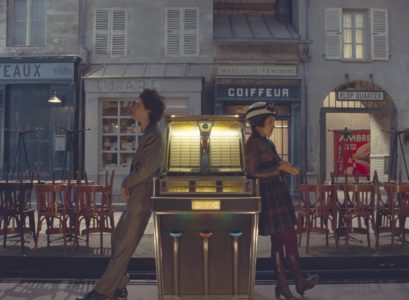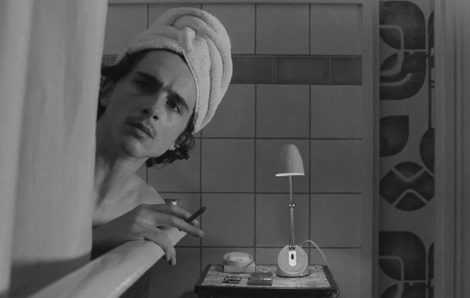The French Dispatch
Front Row at the Movies by Shirrel Rhoades
[mr_rating_result]“The French Dispatch of the Liberty, Kansas Evening Sun” is a fictional newspaper that exists in the new Wes Anderson film of the same name.
Growing out of a series of travelogue columns, the French Dispatch was (the story goes) a collection of factual weekly reports on the subjects of world politics, the arts, and diverse stories of human interest. A bit like The New Yorker, but set in a small European town.
 Anderson calls it a “love letter to journalists.”
Anderson calls it a “love letter to journalists.”
As the movie’s descriptive blurb says, “Arthur Howitzer Jr., the editor of the newspaper The French Dispatch, dies suddenly of a heart attack. According to the wishes expressed in his will, publication of the newspaper is immediately suspended following one final farewell issue, in which three articles from past editions of the paper are republished, along with an obituary.”
Thus, we have a cinematic anthology, a conceit that allows Anderson to give us three entertaining stories: “The Concrete Masterpiece,” “Revisions to a Manifesto,” and “The Private Dining Room of the Police Commissioner.”
In the first, a mentally disturbed artist (Benicio del Toro) serving a prison sentence for murder paints a nude portrait of a prison officer (Léa Seydoux) with whom he has a romantic relationship. And art dealer (Adrien Brody) buys it, causing a sensation that makes the artist famous … but alas, no more paintings are forthcoming from our prisoner. Or are they? A staff-member (Tilda Swinton) of the French Dispatch tells the story.
In the second, a reporter (Frances McDormand) has an affair with the leader (Timothée Chalamet) of a student protest called the “Chessboard Uprising” and helps him write a manifesto for this small revolution. He will become its symbol.
And in the third, a food journalist (Jeffrey Wright) recounts a private dinner with the police commissaire, (Mathieu Amalric) along with an officer (Stephen Park) who also happens to be an excellent chef. During this dinner, the lawman’s son (Winston Ait Hellal) is kidnapped. In an attempt to rescue him, the officer prepares a meal for the crooks that’s laced with poison. But who will survive? Other participants in the kidnapping (Liev Schreiber, Edward Norton, Willem Dafoe, and Saoirse Ronan) are in for a chase.
All of this is bracketed by the umbrella story about the French Dispatch’s founder, his last wishes, closing down the paper, and publishing these three stories in its final edition.
Arthur Howitzer Jr. (Bill Murray), the dead editor, is loosely based on Harold Ross, co-founder of The New Yorker. The staff (Owen Wilson, Elisabeth Moss, Jason Schwartzman, Fisher Stevens, Griffin Dunne, et al.) mourn his passing in the epilogue.
Yes, you have seen many of the named actors in previous Wes Andersen productions such as “The Royal Tenenbaums” (2001), “Moonrise Kingdom” (2012), and “The Grand Budapest Hotel” (2014). He tends to rely on a repertoire company of actors he likes.
 Owen Wilson was his college roommate, and later an ongoing collaborator in his films beginning with “Bottle Rocket” (1996). Bill Murray resuscitated his career as a serious actor in “Rushmore” (1998) and has appeared in every Anderson film since.
Owen Wilson was his college roommate, and later an ongoing collaborator in his films beginning with “Bottle Rocket” (1996). Bill Murray resuscitated his career as a serious actor in “Rushmore” (1998) and has appeared in every Anderson film since.
Wes Anderson may well be the most stylized director working in cinema today. His eccentric films are all but posed, head-on compositions and long shots and close-ups that feel like pages from a pretentious picture book. That is not a criticism, just a way of acknowledging their distinctive appeal. All of his films feature a type of composition known as “planimetric staging” (which involves placing the camera at a 90 degree angle with the subject of the shot.) This is one reason his films are said to have “a unique visual style.”
“I feel I get criticized for style over substance, and for details that get in the way of the characters,” he says. “But every decision I make is how to bring these characters forward.”
Anderson adds, “I have a way of filming things and staging them and designing sets. There were times when I thought I should change my approach, but in fact, this is what I like to do. It’s sort of like my handwriting as a movie director. And somewhere along the way, I think I’ve made the decision: I’m going to write in my own handwriting.”
“The French Dispatch” is currently playing in theaters (you remember theaters, right?).
This is the kind of movie Wes Anderson likes to make, “where there is an invented reality and the audience is going to go someplace where hopefully they’ve never been before. The details, that’s what the world is made of.”
Email Shirrel: srhoades@aol.com


Ratings & Comments
[mr_rating_form]